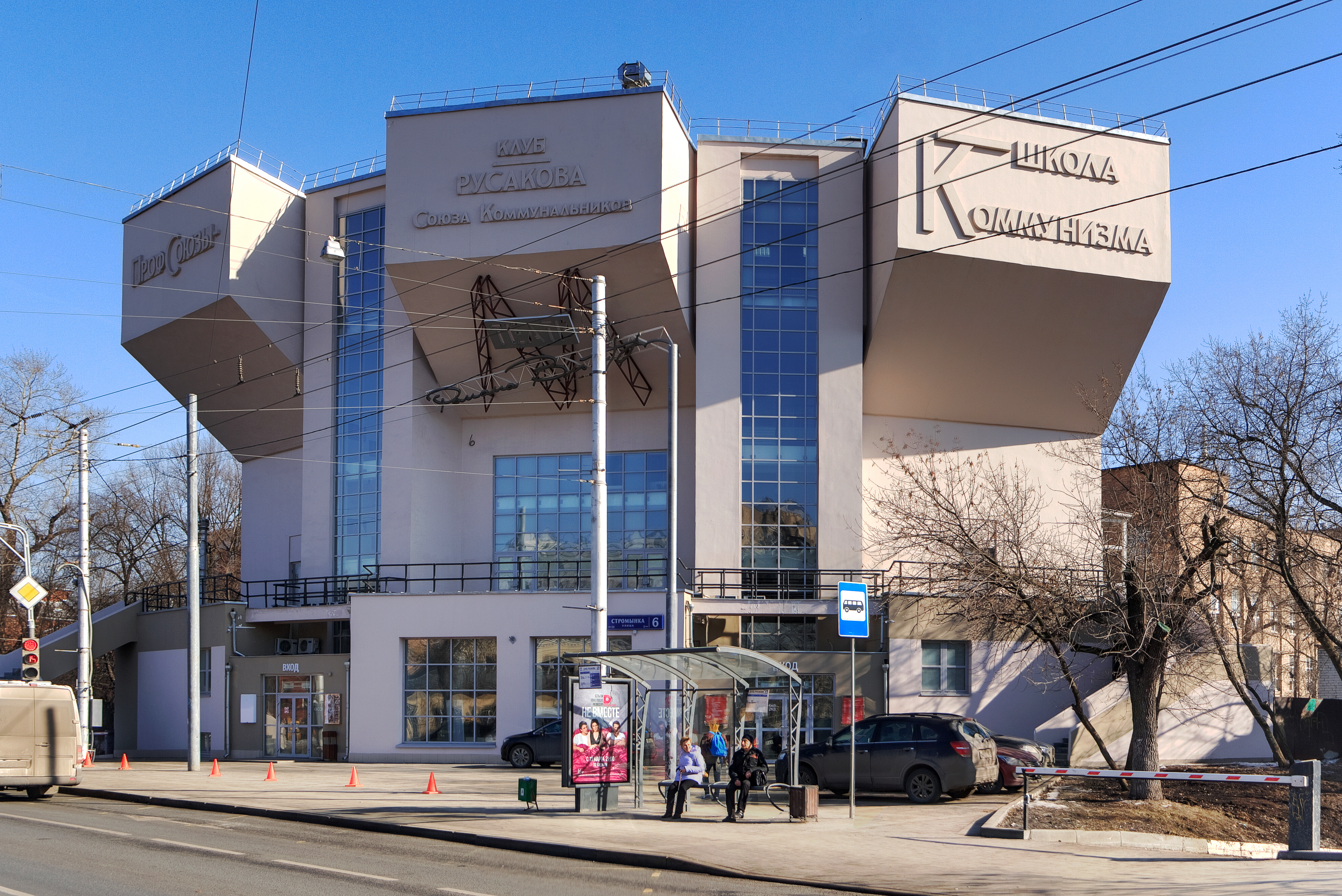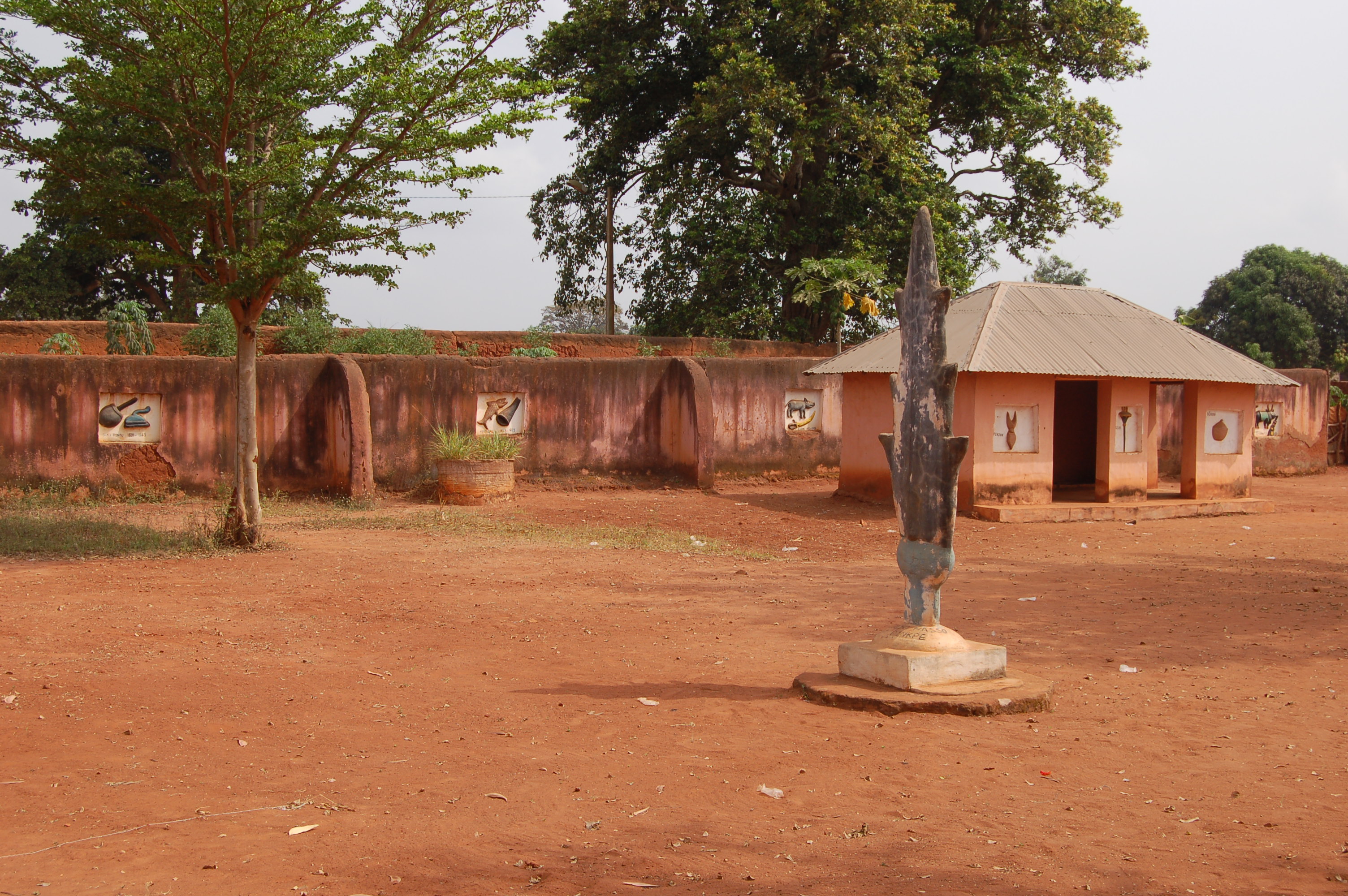|
Rusakov Workers Club
The Rusakov Workers' Club (russian: Дом культуры имени И.В.Русакова (рабочий клуб)) in Moscow is a notable example of constructivist architecture. Designed by Konstantin Melnikov, it was constructed in 1927–28. The club is built on a fan-shaped plan, with three cantilevered concrete seating areas rising above the base. Each of these volumes can be used as a separate auditorium, and combined they result in a capacity of over 1,000 people. At the rear of the building are more conventional offices. The only visible materials used in its construction are concrete, brick and glass. The function of the building is to some extent expressed in the exterior, which Melnikov described as a "tensed muscle". Preservation The building was included in the 1998 World Monuments Watch by the World Monuments Fund to call attention to its very poor condition. According to the Fund the roof and foundations had weakened, the columns were in need of rein ... [...More Info...] [...Related Items...] OR: [Wikipedia] [Google] [Baidu] |
World Monuments Fund
World Monuments Fund (WMF) is a private, international, non-profit organization dedicated to the preservation of historic architecture and cultural heritage sites around the world through fieldwork, advocacy, grantmaking, education, and training. Founded in 1965, WMF is headquartered in New York, and has offices and affiliates around the world, including Cambodia, France, Peru, Portugal, Spain, and the United Kingdom. In addition to hands-on management, the affiliates identify, develop, and manage projects, negotiate local partnerships, and attract local support to complement funds provided by donors. History International Fund for Monuments (1965–1984) The ''International Fund for Monuments'' (IFM) was an organization created by Colonel James A. Gray (1909–1994) after his retirement from the U.S. Army in 1960. Gray had conceived of a visionary project to arrest the settlement of the Leaning Tower of Pisa by freezing the soil underneath, and formed the organization in 196 ... [...More Info...] [...Related Items...] OR: [Wikipedia] [Google] [Baidu] |
Buildings And Structures Completed In 1928
A building, or edifice, is an enclosed structure with a roof and walls standing more or less permanently in one place, such as a house or factory (although there's also portable buildings). Buildings come in a variety of sizes, shapes, and functions, and have been adapted throughout history for a wide number of factors, from building materials available, to weather conditions, land prices, ground conditions, specific uses, prestige, and aesthetic reasons. To better understand the term ''building'' compare the list of nonbuilding structures. Buildings serve several societal needs – primarily as shelter from weather, security, living space, privacy, to store belongings, and to comfortably live and work. A building as a shelter represents a physical division of the human habitat (a place of comfort and safety) and the ''outside'' (a place that at times may be harsh and harmful). Ever since the first cave paintings, buildings have also become objects or canvasses of much artistic ... [...More Info...] [...Related Items...] OR: [Wikipedia] [Google] [Baidu] |
Buildings And Structures Built In The Soviet Union
A building, or edifice, is an enclosed structure with a roof and walls standing more or less permanently in one place, such as a house or factory (although there's also portable buildings). Buildings come in a variety of sizes, shapes, and functions, and have been adapted throughout history for a wide number of factors, from building materials available, to weather conditions, land prices, ground conditions, specific uses, prestige, and aesthetic reasons. To better understand the term ''building'' compare the list of nonbuilding structures. Buildings serve several societal needs – primarily as shelter from weather, security, living space, privacy, to store belongings, and to comfortably live and work. A building as a shelter represents a physical division of the human habitat (a place of comfort and safety) and the ''outside'' (a place that at times may be harsh and harmful). Ever since the first cave paintings, buildings have also become objects or canvasses of much artistic ... [...More Info...] [...Related Items...] OR: [Wikipedia] [Google] [Baidu] |
Russian Avant-garde
The Russian avant-garde was a large, influential wave of avant-garde modern art that flourished in the Russian Empire and the Soviet Union, approximately from 1890 to 1930—although some have placed its beginning as early as 1850 and its end as late as 1960. The term covers many separate, but inextricably related, art movements that flourished at the time; including Suprematism, Constructivism, Russian Futurism, Cubo-Futurism, Zaum and Neo-primitivism. Many of the artists who were born, grew up or were active in what is now Belarus and Ukraine (including Kazimir Malevich, Aleksandra Ekster, Vladimir Tatlin, Wassily Kandinsky, David Burliuk, Alexander Archipenko), are also classified in the Ukrainian avant-garde. The Russian avant-garde reached its creative and popular height in the period between the Russian Revolution of 1917 and 1932, at which point the ideas of the avant-garde clashed with the newly emerged state-sponsored direction of Socialist Realism. Artists and de ... [...More Info...] [...Related Items...] OR: [Wikipedia] [Google] [Baidu] |
Constructivist Architecture
Constructivist architecture was a constructivist style of modern architecture that flourished in the Soviet Union in the 1920s and early 1930s. Abstract and austere, the movement aimed to reflect modern industrial society and urban space, while rejecting decorative stylization in favor of the industrial assemblage of materials. Designs combined advanced technology and engineering with an avowedly communist social purpose. Although it was divided into several competing factions, the movement produced many pioneering projects and finished buildings, before falling out of favour around 1932. It has left marked effects on later developments in architecture. Definition Constructivist architecture emerged from the wider Constructivist art movement, which grew out of Russian Futurism. Constructivist art had attempted to apply a three-dimensional cubist vision to wholly abstract non-objective 'constructions' with a kinetic element. After the Russian Revolution of 1917 it turned its ... [...More Info...] [...Related Items...] OR: [Wikipedia] [Google] [Baidu] |
Buildings And Structures In Moscow
A building, or edifice, is an enclosed structure with a roof and walls standing more or less permanently in one place, such as a house or factory (although there's also portable buildings). Buildings come in a variety of sizes, shapes, and functions, and have been adapted throughout history for a wide number of factors, from building materials available, to weather conditions, land prices, ground conditions, specific uses, prestige, and aesthetic reasons. To better understand the term ''building'' compare the list of nonbuilding structures. Buildings serve several societal needs – primarily as shelter from weather, security, living space, privacy, to store belongings, and to comfortably live and work. A building as a shelter represents a physical division of the human habitat (a place of comfort and safety) and the ''outside'' (a place that at times may be harsh and harmful). Ever since the first cave paintings, buildings have also become objects or canvasses of much artis ... [...More Info...] [...Related Items...] OR: [Wikipedia] [Google] [Baidu] |
Central Bank Of Russia
The Central Bank of the Russian Federation (CBR; ), doing business as the Bank of Russia (russian: Банк России}), is the central bank of the Russian Federation. The bank was established on July 13, 1990. The predecessor of the bank can be traced back to the State Bank of the Russian Empire founded in 1860. The bank is headquartered on Neglinnaya Street in Moscow. Its functions are described in the Constitution of Russia (Article 75) and in federal law. History State Bank of the Russian Empire The decision to create a State Bank of the Russian Empire was made by Emperor Peter III in May 1762, which was modeled on Bank of England and would have the right to issue bank notes. However, due to the coup on 28 June 1762 and the murder of the Czar, the project was not implemented. The outbreak in 1768 of the Russian-Turkish War and deficit of the state budget forced Catherine II, in turn, refer to the idea of issuing a paper money, and in December 1768 she formed the ... [...More Info...] [...Related Items...] OR: [Wikipedia] [Google] [Baidu] |
Commemorative Coin
Commemorative coins are coins issued to commemorate some particular event or issue with a distinct design with reference to the occasion on which they were issued. Many coins of this category serve as collectors items only, although some countries also issue commemorative coins for regular circulation. Subcategories Commemorative coins can be seen as being of one of three types: *'' Regular issue coinage'' are the normal coins intended to be used in commerce every day and are typically issued with the same design for several years, e.g. euro coins. *''Circulating commemoratives'' are intended to be used for commerce, but the design will only be issued for a limited time to commemorate an event, anniversary, person or location, among other items. Examples include the €2 commemorative coins and U.S. 50 State Quarters. *''Non-circulating legal tender (NCLT)'' are coins which are legal tender, and thus can in theory be used to purchase goods or services, but are not intended to b ... [...More Info...] [...Related Items...] OR: [Wikipedia] [Google] [Baidu] |
American Express
American Express Company (Amex) is an American multinational corporation specialized in payment card services headquartered at 200 Vesey Street in the Battery Park City neighborhood of Lower Manhattan in New York City. The company was founded in 1850 and is one of the 30 components of the Dow Jones Industrial Average. The company's logo, adopted in 1958, is a gladiator or centurion whose image appears on the company's well-known traveler's cheques, charge cards, and credit cards. During the 1980s, Amex invested in the brokerage industry, acquiring what became, in increments, Shearson Lehman Hutton and then divesting these into what became Smith Barney Shearson (owned by Primerica) and a revived Lehman Brothers. By 2008 neither the Shearson nor the Lehman name existed. In 2016, credit cards using the American Express network accounted for 22.9% of the total dollar volume of credit card transactions in the United States. , the company had 121.7million cards in force, includ ... [...More Info...] [...Related Items...] OR: [Wikipedia] [Google] [Baidu] |
2000 World Monuments Watch
The World Monuments Watch is a flagship advocacy program of the New York-based private non-profit organization World Monuments Fund (WMF) and American Express to call upon every government in the world, preservation organizations, and other groups and individuals to nominate sites and monuments that are particularly endangered. At the same time, the nominators commit themselves to participate in a carefully planned preservation Preservation may refer to: Heritage and conservation * Preservation (library and archival science), activities aimed at prolonging the life of a record while making as few changes as possible * ''Preservation'' (magazine), published by the Nat ... project. Selection process Every two years, the program publishes a select list known as the Watch List of 100 Most Endangered Sites that is in urgent need of preservation funding and protection. The sites are chosen from these nominations by an independent panel of international experts, based on the signifi ... [...More Info...] [...Related Items...] OR: [Wikipedia] [Google] [Baidu] |
1998 World Monuments Watch
The World Monuments Watch is a flagship advocacy program of the New York-based private non-profit organization World Monuments Fund (WMF) and American Express to call to action and challenge government authorities responsible for important cultural resources to identify sites immediately at risk, and to stimulate public awareness of the tremendous need to preserve The word preserve may refer to: Common uses * Fruit preserves, a type of sweet spread or condiment * Nature reserve, an area of importance for wildlife, flora, fauna or other special interest, usually protected Arts, entertainment, and media ... and create sustainable uses for significant heritage made by man. Selection process Every two years, the program publishes a select list known as the Watch List of 100 Most Endangered Sites that is in urgent need of preservation funding and protection. The sites are nominated by public authorities, local preservation groups, and qualified individuals. An independent pane ... [...More Info...] [...Related Items...] OR: [Wikipedia] [Google] [Baidu] |




_by_Wassily_Kandinsky.jpg)

_10.jpg)



